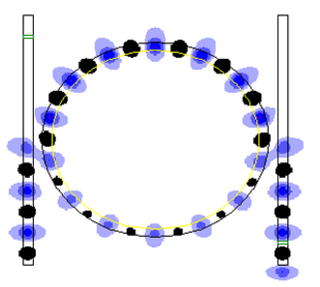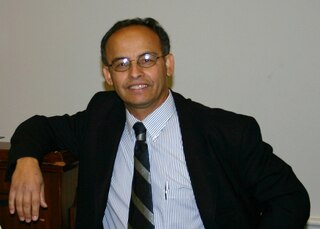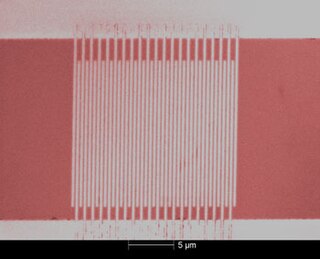
An optical ring resonator is a set of waveguides in which at least one is a closed loop coupled to some sort of light input and output. The concepts behind optical ring resonators are the same as those behind whispering galleries except that they use light and obey the properties behind constructive interference and total internal reflection. When light of the resonant wavelength is passed through the loop from the input waveguide, the light builds up in intensity over multiple round-trips owing to constructive interference and is output to the output bus waveguide which serves as a detector waveguide. Because only a select few wavelengths will be at resonance within the loop, the optical ring resonator functions as a filter. Additionally, as implied earlier, two or more ring waveguides can be coupled to each other to form an add/drop optical filter.
Polaritonics is an intermediate regime between photonics and sub-microwave electronics. In this regime, signals are carried by an admixture of electromagnetic and lattice vibrational waves known as phonon-polaritons, rather than currents or photons. Since phonon-polaritons propagate with frequencies in the range of hundreds of gigahertz to several terahertz, polaritonics bridges the gap between electronics and photonics. A compelling motivation for polaritonics is the demand for high speed signal processing and linear and nonlinear terahertz spectroscopy. Polaritonics has distinct advantages over electronics, photonics, and traditional terahertz spectroscopy in that it offers the potential for a fully integrated platform that supports terahertz wave generation, guidance, manipulation, and readout in a single patterned material.
Deep-level transient spectroscopy (DLTS) is an experimental tool for studying electrically active defects in semiconductors. DLTS establishes fundamental defect parameters and measures their concentration in the material. Some of the parameters are considered as defect "finger prints" used for their identifications and analysis.
Indium gallium arsenide (InGaAs) is a ternary alloy of indium arsenide (InAs) and gallium arsenide (GaAs). Indium and gallium are group III elements of the periodic table while arsenic is a group V element. Alloys made of these chemical groups are referred to as "III-V" compounds. InGaAs has properties intermediate between those of GaAs and InAs. InGaAs is a room-temperature semiconductor with applications in electronics and photonics.
Quantum-cascade lasers (QCLs) are semiconductor lasers that emit in the mid- to far-infrared portion of the electromagnetic spectrum and were first demonstrated by Jérôme Faist, Federico Capasso, Deborah Sivco, Carlo Sirtori, Albert Hutchinson, and Alfred Cho at Bell Laboratories in 1994.
Nanophotonics or nano-optics is the study of the behavior of light on the nanometer scale, and of the interaction of nanometer-scale objects with light. It is a branch of optics, optical engineering, electrical engineering, and nanotechnology. It often involves dielectric structures such as nanoantennas, or metallic components, which can transport and focus light via surface plasmon polaritons.

Ching Wan Tang is a Hong Kong–American physical chemist. He was inducted into the National Inventors Hall of Fame in 2018 for inventing OLED, and was awarded the 2011 Wolf Prize in Chemistry. Tang is the IAS Bank of East Asia Professor at the Hong Kong University of Science and Technology and previously served as the Doris Johns Cherry Professor at the University of Rochester.

Mounir Laroussi is a Tunisian-American scientist. He is known for his work in plasma science, especially low temperature plasmas and their biomedical applications.

The superconducting nanowire single-photon detector is a type of optical and near-infrared single-photon detector based on a current-biased superconducting nanowire. It was first developed by scientists at Moscow State Pedagogical University and at the University of Rochester in 2001. The first fully operational prototype was demonstrated in 2005 by the National Institute of Standards and Technology (Boulder), and BBN Technologies as part of the DARPA Quantum Network.

Sorab (Soli) K. Ghandhi was a professor Emeritus at Rensselaer Polytechnic Institute (RPI) known for his pioneering work in electrical engineering and microelectronics education, and in the research and development of Organometallic Vapor Phase Epitaxy (OMVPE) for compound semiconductors. He was the recipient of the IEEE Education Award "For pioneering contributions to semiconductor and microelectronics education" in 2010.

Whispering-gallery waves, or whispering-gallery modes, are a type of wave that can travel around a concave surface. Originally discovered for sound waves in the whispering gallery of St Paul's Cathedral, they can exist for light and for other waves, with important applications in nondestructive testing, lasing, cooling and sensing, as well as in astronomy.
Richard Magee Osgood Jr. was an American applied and pure physicist. He was Higgins Professor of Electrical Engineering and Applied Physics at Columbia University.

Plasmonics or nanoplasmonics refers to the generation, detection, and manipulation of signals at optical frequencies along metal-dielectric interfaces in the nanometer scale. Inspired by photonics, plasmonics follows the trend of miniaturizing optical devices, and finds applications in sensing, microscopy, optical communications, and bio-photonics.
A nanophotonic resonator or nanocavity is an optical cavity which is on the order of tens to hundreds of nanometers in size. Optical cavities are a major component of all lasers, they are responsible for providing amplification of a light source via positive feedback, a process known as amplified spontaneous emission or ASE. Nanophotonic resonators offer inherently higher light energy confinement than ordinary cavities, which means stronger light-material interactions, and therefore lower lasing threshold provided the quality factor of the resonator is high. Nanophotonic resonators can be made with photonic crystals, silicon, diamond, or metals such as gold.
Diana Huffaker FIEEE, FOSA is a physicist working in compound semiconductors optical devices. She is the current Electrical Engineering Department Chair at the University of Texas at Arlington. Previously, she served as the Sêr Cymru Chair in Advanced Engineering and Materials and as Science Director of the Institute of Compound Semiconductors at Cardiff University. Her work includes compound semiconductor epitaxy, lasers, solar cells, optoelectronic devices, plasmonics, and Quantum dot and nanostructured materials.
Andrew Marc Weiner OSA NAE NAI was an American electrical engineer, educator and researcher known for contributions to the fields of ultrafast optics and optical signal processing. He was the Scifres Family Distinguished Professor of Electrical and Computer Engineering at Purdue University.
Jingyu Lin is a Chinese-American physicist and engineer working in the field of wide bandgap semiconductors and photonic devices. She is a co-inventor of MicroLED. In 2000, the husband-wife research team led by Hongxing Jiang and Jingyu Lin proposed and realized the operation of the first MicroLED and passive driving MicroLED microdisplay. In 2009, their team and colleagues at III-N Technology, Inc. and Texas Tech University realized and patented the first active driving MicroLED microdisplay in VGA format by heterogeneously integrating MicroLED array with Si CMOS active-matrix driver.

Igor V. Minin, is a Russian physicist, corresponding member of the Russian Academy of Metrology, and a full professor of Physics at the Tomsk Polytechnic University. He became known for his contribution to the creation of new directions in science: THz 3D Zone plate, Mesotronics, and subwavelength structured light, including acoustics and surface plasmon.
Susan Davis Allen is an American engineering professor and academic administrator. She is currently Associate Dean of Research for the College of Engineering and Distinguished Professor of Mechanical Engineering at Embry-Riddle Aeronautical University. Her research has spanned multiple applications of lasers and optics, including spectroscopy, laser sensors, laser ablation, micromachining, and others.
Alan David White was an American physicist, known primarily as one of the inventors of the visible helium-neon laser.







